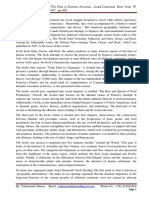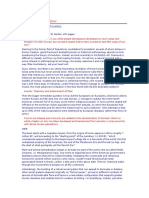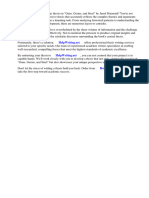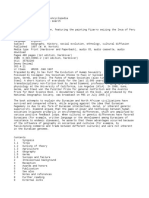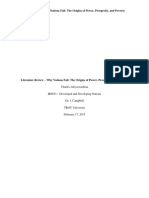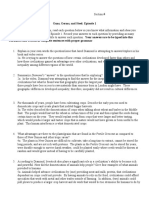Guns Germs and Steel: The Fates of Human Societies
Chapter 1: "Yali's Question"
Jared Diamond begins with a personal anecdote about his conversation with Yali, a politician and
intellectual from New Guinea. Yali asks Diamond why white people, and Western societies in general,
have so much more cargo (material wealth, technology, and resources) than New Guineans and other
non-Western peoples. This question is pivotal, as it highlights a core inquiry: how did different societies
around the world arrive at such differing levels of development and power?
Diamond reflects on various explanations for these disparities, dismissing notions that attribute them to
racial or intellectual superiority. Instead, he emphasizes that the differences in societal progress can be
traced back to environmental factors and geographic advantages. The chapter sets the tone for the book's
thesis by insisting that understanding these factors is crucial for explaining the fates of human societies.
Chapter 2: "The Sweep of History"
In the second chapter, Diamond broadens the scope to cover the history of human societies over the last
13,000 years, emphasizing the role of geography and environment in shaping civilizations. He discusses
the transition from hunter-gatherer lifestyles to agriculture, which he argues was a crucial turning point.
This agricultural revolution allowed certain societies to accumulate surplus food, leading to population
growth, social stratification, and the development of more complex political organizations.
Diamond elaborates on the factors that influenced the success of agriculture around the world. He
explains that some regions were naturally richer in domesticable plants and animals, which facilitated
agriculture. For example, areas in the Fertile Crescent, Mesoamerica, and the Andes had access to a
greater diversity of easily domesticable species, while other regions, such as Australia and parts of New
Guinea, had much less.
He also discusses the concept of "geographic luck"—the idea that some societies were situated in more
favorable environments than others. This luck, according to Diamond, led to differences in the rates at
which societies could progress technologically and politically. Furthermore, he touches on how the spread
of innovations, agricultural practices, and technologies were hindered or facilitated by geographic barriers
such as mountains and oceans.
Diamond uses comparative statistics and case studies from various societies to illustrate his points,
ultimately concluding that the factors influencing societal trajectory are largely rooted in geography and
environment rather than race or culture. This chapter establishes a foundation for the book's primary
arguments about how guns, germs, and steel, as symbols of technological power, play into the broader
narrative of human history.
### Conclusion of the Summary
Through these first two chapters, Diamond introduces key concepts that will be further explored
throughout "Guns, Germs, and Steel," framing the dialogue around environmental determinism and the
�historical processes that have led to the uneven distribution of wealth and power in the world. This sets
the stage for his in-depth exploration of how these factors have influenced the development of societies.
Other summary:
Chapter 1: Up to the Starting Line
In this chapter, Diamond explores the question of why different societies developed at different rates. He
discusses the factors that contributed to the uneven development of civilizations across the globe. Key
points include:
Geographical Differences: Diamond argues that environmental factors, such as the availability of
domesticable plants and animals, significantly influenced the development of societies. Societies with
access to fertile land and abundant resources had advantages in agriculture, leading to population growth
and technological advancement.
Food Production: The transition from hunter-gatherer societies to agricultural ones allowed for more
stable food supplies. This shift laid the groundwork for larger populations and the establishment of
complex societies.
Cultural Development: Societies that developed agriculture first were able to generate surplus food, which
supported non-farming specialists, leading to advancements in technology, political organization, and
culture.
Contingency and History: Diamond emphasizes that historical events, such as the domestication of
specific plants and animals in certain regions, were largely contingent on geography and climate rather
than inherent differences among people.
Chapter 2: A Natural Experiment of History
In this chapter, Diamond introduces the concept of "natural experiments" to illustrate how different
societies have developed in response to environmental challenges. He uses the example of the different
fates of the indigenous populations of the Americas and Eurasia. Key points include:
Geographical Context: Diamond compares the societies of New Guinea and nearby Australia to those of
Eurasia. He explains that New Guinea had access to diverse crops and animals that could be
domesticated, which led to advanced agricultural practices.
Outcomes of Colonization: He discusses how the Spanish conquest of the Inca Empire in South America
illustrates the impact of guns, germs, and steel. The technological advantages of the Spaniards, alongside
the devastating effects of diseases like smallpox, played crucial roles in their conquests.
Cultural Evolution: Diamond argues that the differing outcomes of societies can largely be attributed to
their environments rather than any innate superiority. The chapter emphasizes the importance of
understanding history through the lens of geography and the environment.

